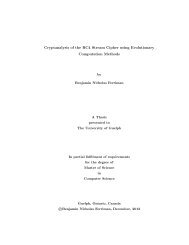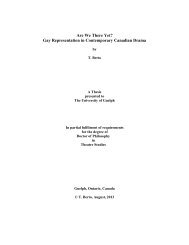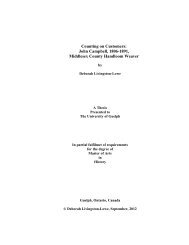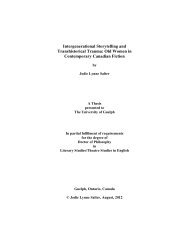THESIS - ROC CH ... - FINAL - resubmission.pdf - University of Guelph
THESIS - ROC CH ... - FINAL - resubmission.pdf - University of Guelph
THESIS - ROC CH ... - FINAL - resubmission.pdf - University of Guelph
Create successful ePaper yourself
Turn your PDF publications into a flip-book with our unique Google optimized e-Paper software.
7.4.3 ME<strong>CH</strong>ANICAL PROPERTIES OF TIO2/CELLULOSE/SPI BLEND FILM<br />
Mechanical properties <strong>of</strong> SPI films incorporated cellulose and/or TiO 2 were obtained for<br />
RH <strong>of</strong> 43, 58 and 84% (Table 7.2). Figure 7.7 displays the tensile properties between all<br />
treatments. Similar to previous results, increasing RH translated to a decrease in tensile<br />
strength. For SPI/TiO2 and SPI/fiber blend films, results were also similar to previous findings<br />
where the optimal concentration for maximum strength was near 0.25% w/w. However, when<br />
0.25% w/w <strong>of</strong> TiO2 was used as a coupling agent, the optimal loading <strong>of</strong> cellulose fiber shifted to<br />
1% w/w. A positive correlation between tensile strength and TiO 2-coupled fiber concentration<br />
was seen across all levels <strong>of</strong> RH. At 84% RH, the tensile strength <strong>of</strong> TiF1.0 is clearly improved<br />
over Ti1.0 and F1.0 showing a synergistic effect. The positive trend suggests that cellulose<br />
incorporation beyond 1% w/w may further increase material strength and promote higher<br />
cellulose utilization.<br />
101

















